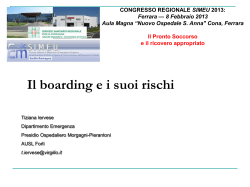
! Patient Safety- do it yourself How to learn about safer healthcare
Patient Safety- do it yourself! How to learn about safer healthcare 21. September 2011 Workshop on Good Practices in Patient Safety Zagreb Günther Jonitz, M.D. President of the Berlin Chamber of Physicians Member of the Board of the German Medical Association Chairman of the German Coalition for Patient Safety Î „The Professional Approach“ Quality and safety is the primary concern of medicine. „Value based health care“ 21. September 2011 Dr. med. Günther Jonitz 2 Patient care has become a challenging and risky issue: Î Quality and safety on the agenda 21. September 2011 Dr. med. Günther Jonitz 3 Prepositions ¾ Comprehensive competencies for health care workers „Patient safety can be learned as a part of professionalism“ 21. September 2011 Dr. med. Günther Jonitz 4 Education and training for Patient Safety ¾ Knowledge ¾ Skills ¾ Behaviour/ attitude!! Î “Getting to the heart of the doctors.” Colin Feek, MinHealthNZ, 2006 21. September 2011 Dr. med. Günther Jonitz 5 Human Factors System failure Inadequate Training 21. September 2011 Rall Source: Marcus ¾ 70% of causes of accidents ¾ Not covered enough in medical training or education ¾ ¾ ¾ ¾ It´s not the bad doctor Complex, coupled, kybernetic Latent errors „predictably unpredictable“ ¾ Current training does not reflect the real-world problems of the ill-structured patient care reality Dr. med. Günther Jonitz 6 Solutions/ Organisational level Knowledge about dealing with incidents increases Inefficent organisational structures and lack of proper communication instead of „individual blame“ „WHY“ not „WHO“ New procedures for incident prevention are available Critical Incident Reporting and Learning Systems Professional Training, Education, Certification, Procedures… 21. September 2011 Dr. med. Günther Jonitz 7 …a holistic approach is needed! Î broad range of contents! Î all professions! 21. September 2011 Dr. med. Günther Jonitz 8 CPD/ Continous Professional Development ¾ Cooperation and teamwork ¾ Communication ¾ Leadership ¾ Management (of health care organisations) ¾ Knowledge-management ¾ Human Factor ¾ Empathy ¾ … 21. September 2011 Dr. med. Günther Jonitz 9 http://www.forum-patientensicherheit.de/ service/literatur/pdf/ fbkonzept_patientensicherheit_english.pdf 21. September 2011 German Curricula/ National level: •Quality Management •Evidence Based Medicine •Patient Safety •Leadership •Peer Review •Managed Care Dr. med. Günther Jonitz 10 Implementation/ Regional level: Examples from Berlin 21. September 2011 Dr. med. Günther Jonitz 11 One Example: Patient Safety Training Training course of 3,5 days duration, interactive seminar: Case studies, lectures, group discussion, group work, group assignments Target group • All medical professions, in particular those people concerned with accident analysis, incident analysis, incident reporting and quality assurance Learning outcomes • Ability to analyse complex incidents on several levels; knowledge about human behaviour and human strengths/weaknesses (psychology of Human Factors) • • 21. September 2011 Aim: To give participants a systematic understanding of how incidents come about in complex organisations and how these incidents and potential damage might be analysed in order to develop preventive measures. Special attention is given to methods of root cause analysis, observation and analysis of organisational factors including teamwork and communication as well as factors conducive to a safety culture. Dr.www.german-coalition-for-patient-safety.org med. Günther Jonitz 12 Content: Root Cause Analysis 21. September 2011 ¾ Patient safety and concepts on safety ¾ Mistake development: models and analysis methods ¾ Human Factors: - Team and leadership - Organisation environment and safety culture - Incident management and prevention - Conditions for incident analysis ¾ Applied process analysis ¾ Models and methods ¾ Communicating analytic results ¾ Communicating with patients and their families about incidents and analytic results ¾ Implementation of analytic results Dr. med. Günther Jonitz 13 21. September 2011 EUNETPAS -REPORT: www.eunetpas.eu Dr. med. Günther Jonitz 14 CIRS-NETWORK GERMANY, www.cirsmedical.de 21. September 2011 Dr. med. Günther Jonitz 15 www.cirsmedical.de Round about 2450 reports (in all groups, without excluding double reports) Report groups: ¾ CIRSmedical.de ¾ CIRS-AINS/ Anaesthesiology: 60 hospitals ¾ Report Network Berlin: 20 hospitals ¾ Report Network Munich: 5 hospitals ¾ Other report groups: 11 hospitals ¾ 9 further groups for different health care institutions 21. September 2011 Dr. med. Günther Jonitz 16 German Coalition of Patient Safety Î Working Group „Education and Training“ present activity: Draft version of a „Curriculum Patient Safety“ Î all health care professions Î practical orientation! …work in progress… 21. September 2011 Dr. med. Günther Jonitz 17 Simulation Training to enhance patient safety http://www.tupass.de/ 21. September 2011 Marcus Rall TüPASS Centre for Patient Safety and Simulation Tubingen since 10 years Department of Anaesthesiology andGünther Intensive Dr. med. JonitzCare Medicine University of Tubingen, Germany 18 http://www.europatientsafety.eu/epsc/ 21. September 2011 Dr. med. Günther Jonitz 19 „Aviation meets Medicine“ Steps: ¾Briefing ¾Checklist ¾Feedback ¾Debriefing Airport Hannover Picture: Dr. sc. mil. Goepfert, Dr. med. Rall 21. September 2011 Dr. med. Günther Jonitz 20 Key factors Safety and Learning Culture: Reflective practice at the system and at the individual level ¾ „Learning“ system ¾ Responsibility ¾ Cooperation ¾ Value based leadership 21. September 2011 Dr. med. Günther Jonitz 21 No more management by „mechanisation“ but „humanisation“ !! „Patient safety is not about constructing a machine, but growing a garden!“ Günther Jonitz 21. September 2011 Dr. med. Günther Jonitz 22 Quality Assurance and Patient Safety is the re-discovery of primary medical virtues on systematic ground. 21. September 2011 Dr. med. Günther Jonitz 23 “Not enough money is being spent on safety, so be careful.” THANK YOU! 21. September 2011 Dr. med. Günther Jonitz g.jonitz@aekb.de 24
© Copyright 2025












![” ⊙ Prohibited Substances [1] Anabolic-Androgenic Steroids](http://cdn1.abcdocz.com/store/data/000006330_2-6488874179c020189ebf4ca4aba01440-250x500.png)
